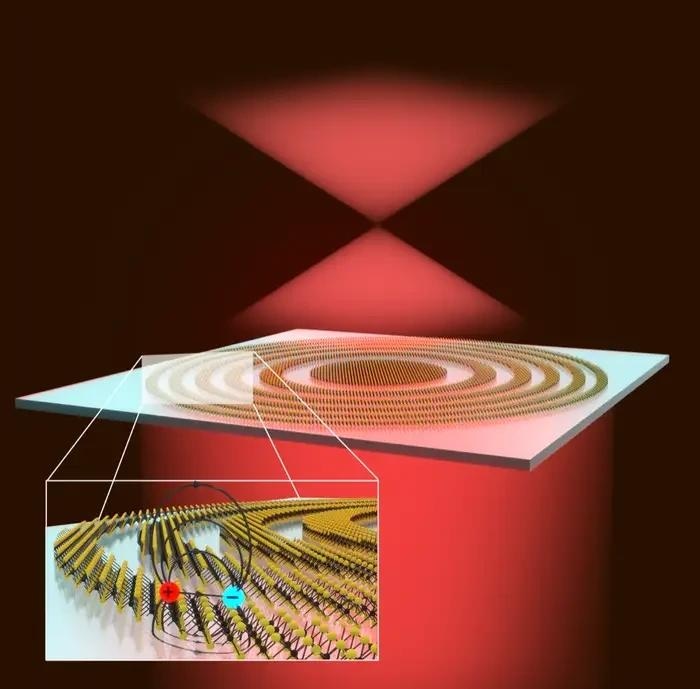Physicists from Stanford University and the University of Amsterdam have created a flat lens that is only three atoms thick and uses quantum effects. One layer of tungsten disulfide, or WS2, a special material, was used to create a 0.0000006 mm, or 0.6 nm, thick flat lens, which is the thinnest lens on Earth. The study has been published in the journal Nano Letters.

The thinnest lens on Earth, made of concentric rings of tungsten disulphide (WS2), uses excitons to efficiently focus light. The lens is as thick as a single layer of WS2, just three atoms thick. The bottom left shows an exciton: an excited electron bound to the positively charged ‘hole’ in the atomic lattice. Image Credit: Ludovica Guarneri and Thomas Bauer.
When people imagine a lens, they usually visualize a piece of curved glass. This type of lens works by bending (refracted) light as it enters and exits the glass, giving the impression that objects are closer or larger than they actually are. For almost two millennia, curved lenses have been utilized for various purposes, such as studying the movements of far-off planets and stars, revealing microorganisms, and enhancing vision.
One layer of tungsten disulfide, or WS2, a special material, was used to create a half-millimeter-wide flat lens that is only 0.0000006 millimeters, or 0.6 nanometers, thick. As a result, it is now the smallest lens on Earth.
Instead of depending on a curved shape, the lens is composed of concentric WS2 rings with gaps between them. This lens, also known as a “zone plate lens” or “Fresnel lens,” concentrates light by diffraction rather than refraction.
The size and spacing between the rings determine the lens's focal length in relation to the wavelength of light that strikes it. This design concentrates red light at a distance of 1 mm from the lens.
Quantum Enhancement
This lens is special because it uses quantum effects in WS2 to achieve its focusing efficiency. Thanks to these phenomena, the material can effectively absorb and re-emit light at particular wavelengths, giving the lens an inherent advantage in performing better at these wavelengths.
WS2 first absorbs light by elevating an electron's energy state. Owing to the material's very thin structure, an “exciton” is created when a negatively charged electron and the positively charged “hole” it leaves in the atomic lattice are drawn to one another by electrostatic attraction.
These excitons swiftly vanish when electrons and holes combine to emit light. This re-emitted light increases the lens’s efficiency.
The scientists discovered a distinct peak in lens efficiency for the precise wavelengths of light emitted by excitons. While the impact is noticeable at ambient temperature, the lenses become more efficient when chilled. This is because excitons function better at lower temperatures.
Augmented Reality
Another distinguishing property of the lens is that, while some light traveling through it produces a strong focus point, most light passes through untouched. While this may appear to be a drawback, it offers new possibilities for future technological applications.
The lens can be used in applications where the view through the lens should not be disturbed, but a small part of the light can be tapped to collect information. This makes it perfect for wearable glasses such as for augmented reality.
Jorik van de Groep, Study Author, University of Amsterdam
The researchers are currently working on inventing and testing more complicated and multifunctional optical coatings with electrically adjustable functions (such as light focusing).
van de Groep added, “Excitons are very sensitive to the charge density in the material, and therefore we can change the refractive index of the material by applying a voltage.”
Journal Reference:
Guarneri, L., et al. (2024) Temperature-Dependent Excitonic Light Manipulation with Atomically Thin Optical Elements. Nano Letters. doi.10.1021/acs.nanolett.4c00694